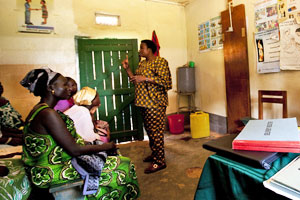Introduction (continued)
 The readiness, willingness, and ability measures of the Cleland, Ndugwa, and Zulu (2011) paper tap into both demand- and supply-side determinants of contraceptive use. The supply-side metric used in their analysis, ability, is a measure derived from women’s knowledge of methods of contraception and where to obtain them, but it does not measure availability of and access to providers, commodities, and services. Therefore, we sought to build on the findings of Cleland, Ndugwa, and Zulu by undertaking additional analyses of supply-side differences between countries in eastern and western Africa, all of which are classified as having a health workforce crisis as measured by the health worker density ratio (World Health Organization 2006). Specifically, our study’s objective was to explore if and how health workforce measures differ between eastern and western Africa, in an effort to identify factors that may have helped one group of health workforce crisis countries in eastern Africa to achieve important gains in CPR, while another group of crisis countries in western Africa has not.
The readiness, willingness, and ability measures of the Cleland, Ndugwa, and Zulu (2011) paper tap into both demand- and supply-side determinants of contraceptive use. The supply-side metric used in their analysis, ability, is a measure derived from women’s knowledge of methods of contraception and where to obtain them, but it does not measure availability of and access to providers, commodities, and services. Therefore, we sought to build on the findings of Cleland, Ndugwa, and Zulu by undertaking additional analyses of supply-side differences between countries in eastern and western Africa, all of which are classified as having a health workforce crisis as measured by the health worker density ratio (World Health Organization 2006). Specifically, our study’s objective was to explore if and how health workforce measures differ between eastern and western Africa, in an effort to identify factors that may have helped one group of health workforce crisis countries in eastern Africa to achieve important gains in CPR, while another group of crisis countries in western Africa has not.
It is important to note that many factors other than health workforce variables are critical in determining levels and trends in CPR, including demand for family planning, contraceptive commodity supply, and sociocultural factors such as female education. However, the investigation of non-health workforce variables or the interaction between health workforce and non-health workforce variables is beyond the scope of this study.

